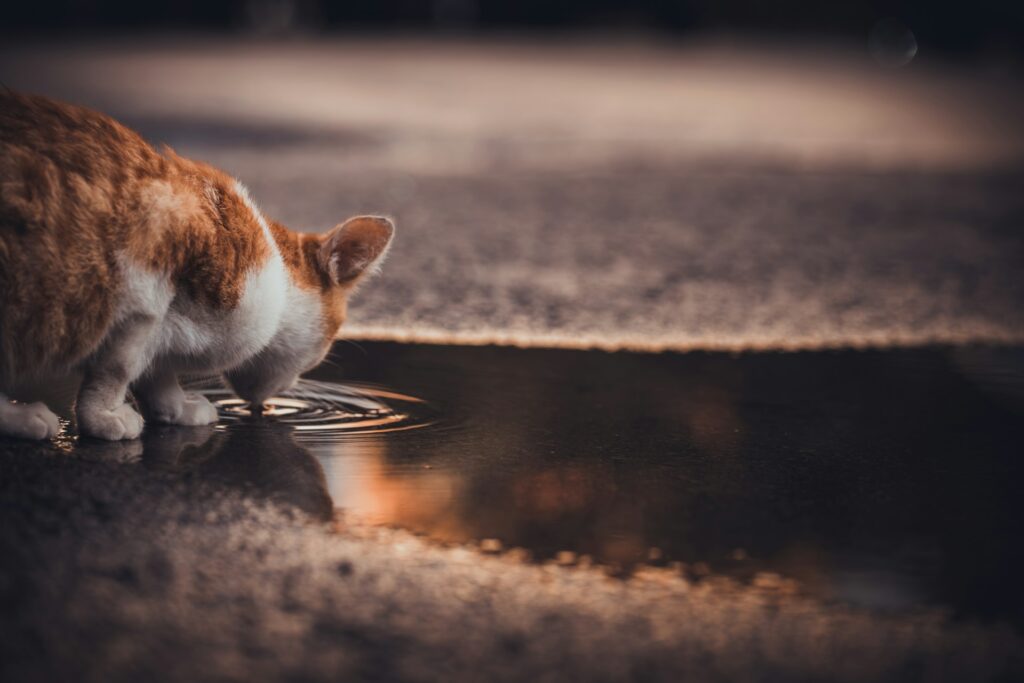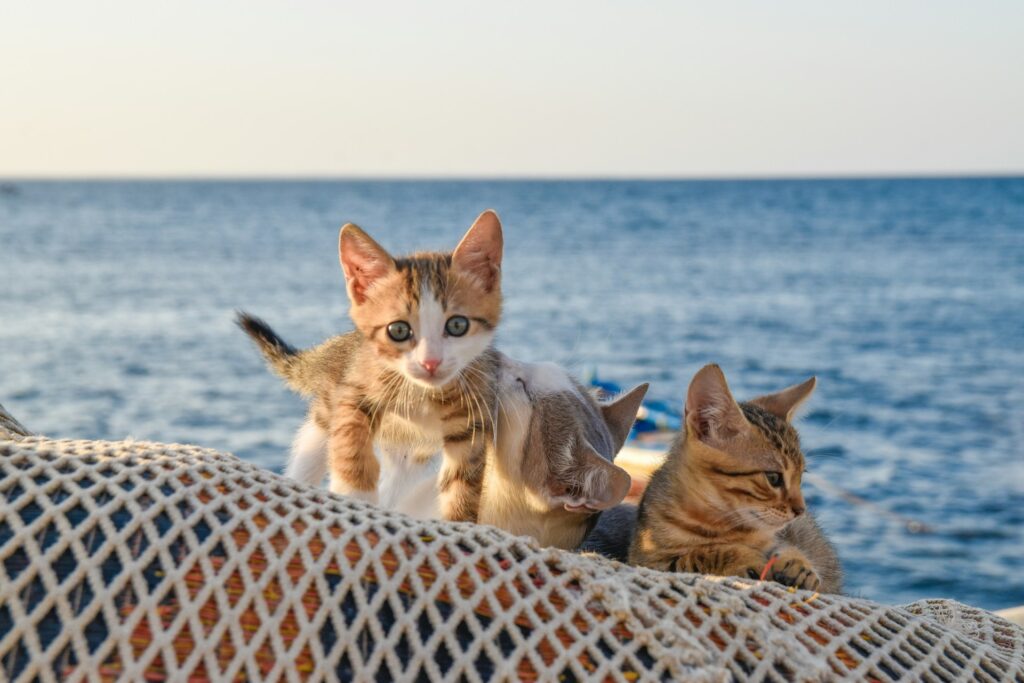Learn about Can Cats Swim. Discover which breeds love water, swimming benefits, safety tips, and how to help your cat enjoy swimming safely and confidently.
All cats are born swimmers. Cats swim by instinct, paddling and floating in water. However, not all cats like water, and many can swim if needed. Some breeds enjoy swimming, but most house cats will avoid water if they can because it makes them uncomfortable or is just something they haven’t done too often before.
Can Cats Swim?
Yes, cats are natural swimmers because they have powerful appendages and limbs, and their bodies are flexible. Most domestic cats dislike water, but there are breeds such as the Turkish Van that enjoy swimming. Swimming may be safe and healthy in its awayyshould be done gradually but as a whole, cats tend to keep themselves dry.
5 Benefits of Swimming for Cats
- Low-Impact Exercise: Swimming gives a very low impact and gentle exercise, it is easy on the joints, hence suitable for the ageing cat or even the cat with arthritis.
- Improves Cardiovascular Health: Swimming increases what the heart and lungs can do, and in turn, a cat can keep the cardiovascular system wide open and stay longer with the increased stamina.
- Builds Muscle Strength: Water resistance contributes to an improvement of the muscle tone and mobility as it aids in equal strengthening of the muscles.
- Mental Stimulation: Playing with water may be mentally stimulating and can relieve boredom and fear because it satisfies your cat’s curiosity and senses.
- Weight Management: Swimming also burns calories effectively, and this aids overweight cats to lose weight and have a healthy body condition.

Keeping Your Cat Safe Around Water
Use of Life Vests
Cats may need additional safety with the use of specially designed life jackets. The vests are good at keeping the cat afloat, and in case it falls in the water, panic is minimized. It is always important to ensure the fit and comfort of the vest on the cat.
Check Water Temperature
You can never assume that the water is warm enough before letting your cat go close to it. Cold water may produce shock or even hypothermia, and hot water may burn off skin. Warm water is the safest water in which to take part in a water activity with your cat.
Secure Pool Areas
Pools or ponds should be provided with safe fencing to avoid falling accidentally. Putting fences or covers would minimise the chances of your cat falling into water without supervision. It is particularly necessary in case your cat is a curious animal or has a history of wandering into risky places.
Watch for Hazards
Watch out for any dangers at the water site, such as this includes sharp items, heavy flow of water,r, or chemicals like chlorine. Exclude or bar dangerous areas to prevent your cat from being injured, poisoned, or even drowned in them.
Dry Your Cat Thoroughly
A dry, soft towel should dry your cat after any encounter with water. Damp fur produces chills, irritations, and skin infections. Be sure to dry the places that are difficult to reach, such as under the legs and belly, to keep your cat warm, healthy.
Cat breeds that may be particularly fond of swimming:
Big, sturdy felines whose fur is resistant to water, Maine Coons are inquisitive and usually like splashing in the water or swimming.
The Japanese Bobtails are also known to be playful and may have an interest in water, and they like to splash and swim.
American Bobtails are versatile and playful, and at times have swimming skills and adapt well to being near water too.
Bengals are active and adventurous, and they always seem to be fascinated by water and might like swimming or having fun in water.
As wild descendants, the Savannah cats are playful and curious creatures who love to explore and swim in the water.
Other cats, such as the Manx cat, may be able to endure water, and even wade or swim if built properly and have a punchy character.
Being waterproof with a thick coat, these tough cats frequently enjoy being around water and can even like swimming.
Curious and active Abyssinians can also investigate water and sometimes appear remarkably tolerant or interested in swimming.
Known to be fond of wat,e, the Turkish Vans are aggressive water lovers and love to swim as well as play in the water, and that is why they are labeled the swimming cat.
They are elegant and smart with a tendency to have some interest in water; therefore, they can be quite comfortable in the water and might enjoy splashing around.
Some of our best tips to keep your cat safe around water:
- Never leave your cat alone near water; you should keep a close look at them as you do with children, not assuming that they are safe for even a minute.
- Gently introduce your cat to swimming, where possible. Be slow, slow, go easy, and reassure them a lot so they feel comfortable.
- It is important to have a fence or barrier around the pool so that your cat does not enter the pool carelessly.
- Wipe your cat dry after any swim, bath, or other play with water, particularly the ears, which can become quite painful when they become infected with moisture.
- A life vest will offer additional safety and security on the water during swim training sessions for your cat.
Training Cats to Enjoy Water
Place water in a couple of drops at a time, and your cat will explore it as it feels comfortable. Make use of toys and treats to generate a positive experience, which will direct them to attach a personal sense of water without being scared.
1. Creating a Positive Environment
It is important that a place is made which is calm, so that it is safe and warm water and encouragement are provided. Never force your cat to do something as he/she does not trust you at the moment. Instead, use praise. Cats are more comfortable with soft lighting, and they feel safe in familiar surroundings.
2. Specific Training Techniques
Make shallow water-play the initial and reward the calm behavior. When your cat comes close to water, use interactive toys and praise. Continue exposing the child to the activity at a low level and observe the comfort, making the process enjoyable and stress-free.

FAQs
Can cats swim if they fall into a pool?
Yes, usually cats are capable swimmers, but if they were to fall into a pool, they would probably panic and become tired quickly. That’s why supervision is so important for their safety.
Do cats like to swim in water?
By nature, cats will almost always avoid swimming and the water in which it has to occur, but certain breeds, along with a few individual cats, enjoy playing or swimming, especially when they are introduced to the idea of it at an early age in a gentle, positive way.
Are cats capable of swimming?
The ability to swim in practice presents itself only when swimming has to be done, and swimming is not something that most adult cats would have had much experience of doing, so it doesn’t always result in confident swimmers.
Do cats automatically know how to swim?
Cats know very instinctively to paddle and keep afloat, yet swimming is not something which they tend to practice a lot, so not every cat is a confident swimmer.
Conclusion
Cats are born with a natural swimming ability, but most prefer not to swim because they avoid water. Some breeds take to it with several therapeutic benefits if introduced at the correct age. Always keep your cat away from any water; put safeguards in place and allow him to experience it positively, so he will be comfortable and safe.
